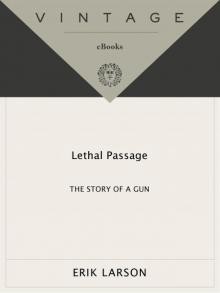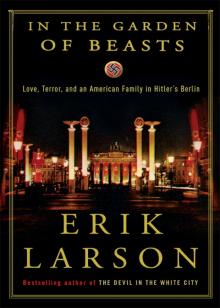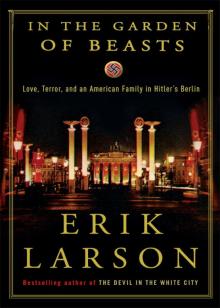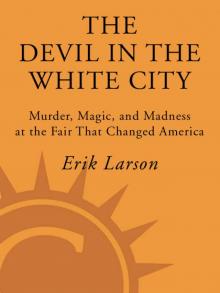- Home
- Erik Larson
Thunderstruck Page 6
Thunderstruck Read online
Page 6
TWO FOR LONDON
MARCONI UNDERSTOOD THAT THE TIME had come to bring his invention into the world. His first thought, or so legend holds, was to offer it to the Italian government, specifically Italy’s post and telegraph authority, only to have his offer rebuffed. But in a brief memoir, his grandson, Francesco Paresce, challenged this account. “No matter how much one might enjoy this idea or how plausible it might seem in a place like Italy even today, there is actually no hard proof whatsoever that he ever did so.” The legend was too tidy and did not give enough weight to the fact that at twenty-one Marconi possessed the shrewd demeanor of a businessman twice his age. Always tuned to the importance of being first to stake claim to a new idea, Marconi may have had his next step in mind all along.
He resolved to bring his invention to London. It was the center of the world, yes, but also the locus of a patent system that granted broad rights to whomever was first to apply for them, not necessarily the inventor or discoverer of the underlying technology.
Marconi’s mother endorsed Marconi’s plans and persuaded her husband that the journey was necessary. In February 1896 mother and son left for London, Marconi carrying a locked box containing his apparatus. He wore a deerstalker cap of the kind that later would be identified with Sherlock Holmes.
On his arrival in England the alert agents of the customs house immediately confiscated his equipment, fearing it was a bomb or other device capable of placing the queen at risk.
In the course of their inspection they destroyed the apparatus.
AT MUNYON’S, CRIPPEN PROSPERED. His career advanced quickly. After a few months in New York he was transferred to Philadelphia, where he and Cora lived for about a year. Next Professor Munyon sent him to Toronto, to manage the company’s office there. He and Cora stayed for six months, then returned to Philadelphia.
All this was good for Crippen’s career, but Cora grew restive. She had spent the better part of a decade married to Crippen and still was no closer to her dream of becoming a diva. She told Crippen she wanted to renew her studies of opera. She wanted only the best and insisted on going to New York.
Ever indulgent, Crippen agreed to pay for an apartment and all her expenses. By this time Professor Munyon was paying him well. Patent medicine was a lucrative field, and money flowed into the company in a torrent. Crippen could afford the cost of Cora’s lessons and her life in New York. What made him uneasy was the prospect of her living alone, without his presence to keep her from associating with other men. Subsequent events suggest that for Cora such freedom may in fact have been as important as the caliber of her song masters.
In 1897 Munyon assigned Crippen his biggest responsibility yet, to take over management of the company’s London office. Munyon proposed to pay him $10,000 a year, an astonishing sum equivalent to about $220,000 in twenty-first-century dollars, and paid in an era when federal income tax did not exist. Crippen told Cora the news, expecting that she would find a move to London an irresistible prospect.
He was wrong. She complained that she could not give up her lessons and told him he would have to go alone, that she would join him later. On the question of when, she was disconcertingly vague.
As always he assented, though now an ocean would separate them and her freedom would be complete.
Full of sorrow and unease, the little doctor sailed to England. It was April 1897. Intent on establishing permanent residence, he brought all his belongings, including supplies of his favored poisons.
He arrived without challenge.
IN LONDON, CRIPPEN AND MARCONI both entered a realm of unaccustomed anxiety. Outwardly the stones of empire remained in place, snug and solid and suitably grimed, but there existed in certain quarters a perception that the world was growing unruly and that Britain and her increasingly frail queen had seen their best days.
London was still the biggest, most powerful city in the world. Its four and a half million people inhabited 8,000 streets, many only a block long, and did their drinking in 7,500 public houses and rode in 11,000 cabs pulled by 20,000 horses, the cab population divided among four-wheeled “growlers” and two-wheeled hansoms, named not for their appearance, which was indeed handsome, but rather for their inventor, Joseph Hansom. Crippen joined an estimated 15,000 of his countrymen already living in London, which number by coincidence equaled the total of known lunatics residing within the city’s five asylums. Most important, London formed the seat of an empire that controlled one-quarter of the world’s population and one-quarter of its land.
Cab whistles screamed for attention, one blast to summon a growler, two for a hansom. Horse-drawn omnibuses clotted the streets. The buses had two levels, with open-air “garden seating” on top, reached by a stairwell spiraling in a manner that allowed ladies to ascend without concern. Motorcars, or simply “motors,” added a fresh layer of noise and stench and danger. In 1896 their increasing use forced repeal of a law that had limited speed to a maximum of two miles per hour and required a footman to walk ahead carrying a red flag. The new Locomotives (on Highways) Act raised the speed limit to fourteen and, wisely, did away with the footmen. Underneath the city there was hell in motion. Passengers descending to the subterranean railways encountered a seismic roar produced by too much smoke, too much steam, and too much noise packed into too small an enclosure, the Tube, into which the trains fit as snugly as pistons in a cylinder.
There was fog, yes, often days of it on end, and with a depth so profound as to classify it as a species distinct from the fogs of elsewhere. Londoners nicknamed these fits of opacity “London particulars.” The fog came thick and sulfurous and squeezed the flare of gas lamps to cats’ eyes of amber that left the streets so dark and sinister that children of the poor hired themselves out as torchbearers to light the way for men and women bent on walking the city’s darker passages. The light formed around the walkers a shifting wall of gauze, through which other pedestrians appeared with the suddenness of ghosts. On some nights the eeriness was particularly acute, especially after an evening of engaging in what had become a common pastime, the holding of séances. The walk home afterward could be a long one, suffused with sorrow and grief and marked by the occasional glance behind.
This turn toward the veil was largely Darwin’s fault. By reducing the rise of man to a process that had more to do with accident than with God, his theories had caused a shock to the faith of late Victorian England. The yawning void of this new “Darwinian darkness,” as one writer put it, caused some to embrace science as their new religion but turned many others into the arms of Spiritualism and set them seeking concrete proof of an afterlife in the shifting planchettes of Ouija boards. In the mid-1890s Britain had 150 Spiritualist societies; by 1908 there would be nearly 400. Queen Victoria herself was rumored to have consulted often with a medium who claimed to be in touch with her dear dead husband, Albert, the prince consort.
There were other signs that the confidence and contentment that had suffused Britain under the queen were beginning ever so slightly to erode. Britain’s birthrate was falling rapidly. The Panic of ’93 had rattled the princes of industry. Britain and France seemed on the verge of war, though in fact events under way in Germany, as yet largely unnoticed by the public, soon would refocus the nation’s attention and bring an end to its long-standing policy of “splendid isolation,” rooted in the perception that because of its military and economic power the empire needed no alliances.
Unsettling, too, was the rising clamor from suffragists seeking the vote for women. The hostility that greeted the movement masked a deeper fear of an upwelling of sexual passion and power. It was kept quiet, but illicit sex occurred everywhere, at every level of society. It was on people’s minds and in their hearts; it took place in back alleys and in elegant canopied beds at country homes. The new scientists of the mind studied sex, and in keeping with the revolution ushered in by Darwin, they sought to reduce it to sequences of stimuli and adaptive needs. Starting in 1897, Henry Havelock Ellis devoted six v
olumes to it: his pioneering Studies in the Psychology of Sex, sprinkled with case studies of unexpected explicitness and perversity. One memorable phrase from volume four, Sexual Selection in Man: “the contact of a dog’s tongue with her mouth alone afterward sufficed to evoke sexual pleasure.”
There existed, too, a rising consciousness of poverty and of the widening difference between how the rich and the poor lived. The Duke and Duchess of Devonshire owned an estate, Chatsworth, so large it could house more than four hundred weekend guests and the squads of servants that accompanied them. The wealthy served meals of extravagance, recalled J. B. Priestley, “probably including, if the chef were up to it, one of those quasi-Roman idiocies, in which birds of varying sizes were cooked one inside the other like nests of Oriental boxes.” Barbara Tuchman, in The Proud Tower, recounted how at one luncheon at the Savoy Hotel for the diva Nellie Melba, guests enjoyed a dessert of fresh peaches, then “made a game of throwing them at passers-by beneath the windows.”
With this new awareness of the great rift between rich and poor came the fear that extremists would seek to exploit class divisions and set Britain tumbling toward revolution. Anarchism had flamed into violence throughout Europe, often with an Italian holding the match. In late 1892 Scotland Yard arrested two Italians who confessed to planning to blow up the Royal Stock Exchange. The aptly named Errico Malatesta—literally, “evil headed”—preached revolution throughout Europe and found a willing audience. On June 24, 1894, a young Italian baker, Sante Caserio, attacked the president of France, Sadi Carnot, with a newly bought dagger and stabbed him to death. A bomb exploded in posh Mayfair but hurt no one. Many in England feared that worse was yet to come and blamed the unrest on policies that allowed too many foreigners to seek refuge within the nation’s borders. There were so many French anarchists in London that one, Charles Malato, published a guide with information about how to avoid the police, including a brief dictionary of useful phrases, among them “Je vous tirerai le nez,” meaning “I will pull your nose.”
But these fears and pressures existed as a background tremolo, audible mainly to the writers, journalists, and reformers who made it their business to listen. Otherwise Britons had much to be pleased with. Though the murder rate was up, overall crime was on the wane. The Metropolitan Police, known more commonly as Scotland Yard, had grown larger and moved to new headquarters at Whitehall on the Victoria Embankment, on the north bank of the Thames. The building and the department became known as New Scotland Yard. The new location at first proved a bit problematic, albeit appropriately so. While excavating its foundation, in the midst of the terror raised by Jack the Ripper, workers had found the torso of a woman, without head, arms, or legs, triggering fears that this too had been Jack’s work. The story got grislier still. A police surgeon tried fitting the torso to a severed arm, with armpit, that had been retrieved from the Thames several weeks earlier. It fit. Next, a reporter used a dog to search the excavation and turned up a left leg. This too fit. Soon afterward a second leg was fished from the Thames.
It did not fit.
Upon examination it proved to be another left leg, causing speculation that a medical student had tossed it into the river as a prank. The case became known as the Whitehall Mystery and was never solved. When the police moved into their new headquarters, one of the departments they left behind at their previous address in Great Scotland Yard was their lost and found division, with 14,212 orphaned umbrellas.
Overall there was a lightening of the British spirit. If any one individual symbolized this change, it was the Prince of Wales, Albert Edward, heir to the throne. In the spring of 1897 he was fifty-six years old and notorious for having an empire-sized appetite for fun, food, and women, the latter despite his thirty-four-year marriage to his wife, Alexandra. That the prince had had sexual dalliances with other women was considered a fact but not a topic for public conversation. Nor was his weight. He drank modestly but adored food. He loved pigeon pie and turtle soup and deer pudding and grouse, partridge, woodcock, and quail, and when the season allowed he consumed mounds of grilled oysters. No one called him fat to his face, for it hurt his feelings, but in private his friends referred to him with affection as “Tum Tum.” When not eating, he was smoking. Before breakfast the prince allowed himself a single small cigar and two cigarettes. Through the remainder of a typical day he smoked twenty cigarettes and a dozen more cigars the diameter of gun barrels.
The prince hated being alone and loved parties and clubs and, especially, going out with friends to the music halls of London. Here he had much company. By the late 1890s music halls with their variety acts had become the most popular form of entertainment in Britain and were fast shedding the seedy image they had acquired earlier in the Victorian era. The number of variety theaters within London multiplied rapidly until the city had five hundred, including such familiar names as Tivoli, Empire, Pavilion, Alhambra, and Gaiety. On any given night a typical variety bill would feature dozens of short acts, called “turns,” including comedy, acrobatics, ventriloquism, mind reading, and acts in which men pretended to be women, and women to be men.
Overseeing this changing empire was Queen Victoria. In 1896 she celebrated her seventy-seventh birthday. She had reigned for nearly sixty years, during which the empire had grown to be the biggest and most powerful ever known. Meanwhile she herself had grown frail. For over three decades she had lived in a state of perpetual mourning over the death in 1861 of her husband. Ever since then, the Widow of Windsor had worn only black satin. She kept a cast of his hand by her bedside, so that she could hold it when she needed comfort. Now her eyesight was failing, and she was plagued by periods of profound sleepiness. She had ruled so long and in such a benign, maternal way that it was hard to think forward to a future in which she did not exist. A man born in the year of her accession, 1837, would by 1897 be on the verge of old age. Yet queen or not, the laws of nature applied. Victoria would die and, given her health and age, probably soon.
As the end of the century approached, a question lay in the hearts of Britons throughout the empire’s eleven million square miles: Without Victoria, what would the world be like?
What would happen then?
THE SECRET BOX
IT IS TEMPTING TO IMAGINE the arrival of Marconi and his mother in London as something from a Dickens novel—the two entering a cold and alien realm, overpowered by the immensity and smoke and noise of the city—but in fact they stepped directly into the warm embrace of the Jameson family and into the center of a skein of blood and business connections that touched a good portion of the British Empire. They were met at Victoria Station by one of Marconi’s cousins, Henry Jameson Davis, and were drawn immediately into the silk and flannel world of London’s upper class, with its high teas, derby days, and Sunday carriage rides through Hyde Park. This inventor had not yet starved, except by choice and obsession, and would not starve now.
The delay caused by the destruction of his equipment amplified his ever-present fear that some other inventor with an apparatus as good as his own or better might suddenly appear. With Jameson Davis’s help, Marconi acquired materials for his apparatus and set to work on reconstruction. He demonstrated the finished product to his cousin and to others in the Jameson diaspora. The effect was as startling as if a dead relative’s voice had just emerged from the mouth of a medium. Here was a means of communicating not just across space but through walls.
They talked of what to do next. A patent was necessary, of course. And a sponsor would help—perhaps the British Post Office, which controlled all telegraphy in Britain.
Here the Jameson network proved invaluable. Through an intermediary, Jameson Davis arranged to have Marconi meet with William Preece, chief electrician of the British Post Office. By dint of his position, Preece, two years from the post office’s retirement age of sixty-five, was the most prominent man in British telegraphy and one of the empire’s best-known lecturers. He was well liked by fellow engineers and employees but was loat
hed by Oliver Lodge and his allies, who together comprised a cadre of theoretical physicists known as “Maxwellians” for their reverence for Clerk Maxwell and his use of mathematics to posit the existence of electromagnetic waves. To the Maxwellians, Preece was the king of “practicians.” He and Lodge had more than once come to metaphoric blows over whether theory or everyday experience had more power to uncover scientific truth.
Marconi knew of Preece and knew that he had attempted with some success to signal across short distances using induction, the phenomenon whereby one circuit can generate a sympathetic current in another. Preece had never heard of Marconi but with characteristic generosity agreed to see him.
Soon afterward Marconi arrived at post office headquarters, three large buildings on St. Martin’s le Grand, just north of St. Paul’s Cathedral. One building, named General Post Office East, occupied the east side of the street and managed the processing and delivery of 2,186,800,000 letters a year throughout the United Kingdom, 54.3 letters per resident, with deliveries in London up to a dozen times a day. Across the street stood General Post Office West, which housed the Telegraph Department, Preece’s bailiwick, where anyone with a proper introduction from “a banker or other well-known citizen” could visit the Telegraph Instrument Galleries and see the heart of Britain’s telegraphic empire. Here in a room measuring 27,000 square feet stood five hundred telegraphic instruments and their operators, the largest telegraph station in the world. Four large steam engines powered pneumatic tubes that allowed the immediate dispatch of telegrams from the galleries direct to offices throughout London’s financial center, the City, and its neighboring district, the Strand, named for the boulevard that fronted the Thames.

 Lethal Passage: The Story of a Gun
Lethal Passage: The Story of a Gun In the Garden of Beasts: Love, Terror, and an American Family in Hitler's Berlin
In the Garden of Beasts: Love, Terror, and an American Family in Hitler's Berlin Dead Wake: The Last Crossing of the Lusitania
Dead Wake: The Last Crossing of the Lusitania The Splendid and the Vile
The Splendid and the Vile Thunderstruck
Thunderstruck Isaac's Storm: A Man, a Time, and the Deadliest Hurricane in History
Isaac's Storm: A Man, a Time, and the Deadliest Hurricane in History In the Garden of Beasts
In the Garden of Beasts The Devil in the White City
The Devil in the White City